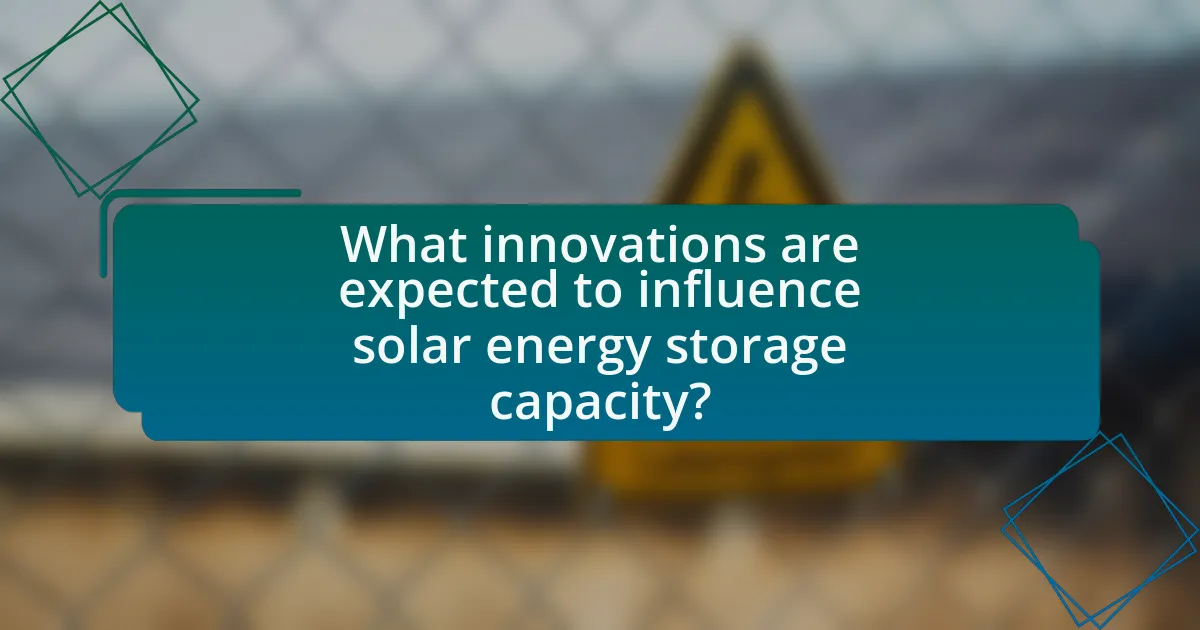The article focuses on future projections for solar energy storage capacity, highlighting an expected increase from approximately 15 gigawatt-hours (GWh) in 2020 to over 600 GWh by 2030. This growth is attributed to advancements in battery technology, decreasing costs, and rising demand for renewable energy solutions. Key metrics for evaluating solar energy storage systems, such as energy capacity and round-trip efficiency, are discussed, along with the factors driving growth, including technological innovations and supportive government policies. The article also addresses challenges faced by the sector, economic influences on adoption, environmental concerns, and the implications of increased storage capacity for energy markets and society.
What are the Future Projections for Solar Energy Storage Capacity?


Future projections for solar energy storage capacity indicate significant growth, with estimates suggesting a global capacity increase from approximately 15 gigawatt-hours (GWh) in 2020 to over 600 GWh by 2030. This growth is driven by advancements in battery technology, decreasing costs, and increasing demand for renewable energy solutions. According to a report by BloombergNEF, the energy storage market is expected to expand at a compound annual growth rate (CAGR) of 30% through the next decade, reflecting a shift towards more sustainable energy systems.
How is solar energy storage capacity currently measured?
Solar energy storage capacity is currently measured in kilowatt-hours (kWh), which quantifies the amount of energy that can be stored and delivered over time. This measurement reflects the total energy capacity of storage systems, such as batteries, used in conjunction with solar power systems. For instance, a battery rated at 10 kWh can supply 10 kilowatts of power for one hour or 1 kilowatt for ten hours. Additionally, metrics such as round-trip efficiency, which indicates the percentage of energy that can be retrieved from storage compared to what was initially stored, are also used to evaluate the performance of solar energy storage systems.
What metrics are used to evaluate solar energy storage systems?
The primary metrics used to evaluate solar energy storage systems include energy capacity, round-trip efficiency, depth of discharge, cycle life, and power rating. Energy capacity measures the total amount of energy the system can store, typically expressed in kilowatt-hours (kWh). Round-trip efficiency indicates the percentage of energy that can be retrieved from the system compared to what was initially stored, with higher values signifying better performance. Depth of discharge refers to the percentage of the total capacity that can be used without damaging the battery, while cycle life represents the number of charge and discharge cycles the system can undergo before its capacity significantly degrades. Power rating, measured in kilowatts (kW), indicates the maximum power output the system can deliver at any given moment. These metrics collectively provide a comprehensive assessment of the performance and viability of solar energy storage systems.
How do these metrics influence future projections?
Metrics such as current solar energy storage capacity, efficiency rates, and cost trends directly influence future projections by providing a quantitative basis for forecasting growth and technological advancements. For instance, the International Energy Agency reported that a 30% increase in energy storage efficiency could lead to a projected doubling of solar energy capacity by 2030. Additionally, metrics on installation costs indicate that a 20% reduction in battery prices over the next five years could significantly accelerate adoption rates, thereby enhancing future capacity projections. These metrics serve as critical indicators for stakeholders to assess market trends and investment opportunities in solar energy storage.
What factors are driving the growth of solar energy storage capacity?
The growth of solar energy storage capacity is primarily driven by advancements in battery technology, increasing demand for renewable energy, and supportive government policies. Advancements in battery technology, such as lithium-ion batteries, have significantly improved energy density and reduced costs, making solar storage more accessible. The global shift towards renewable energy sources, driven by climate change concerns and the need for energy independence, has led to a surge in solar installations, necessitating efficient storage solutions. Additionally, government incentives and regulations aimed at promoting clean energy adoption have further accelerated investments in solar energy storage systems. For instance, the International Energy Agency reported that global battery storage capacity is expected to reach 1,000 GWh by 2040, reflecting the growing integration of solar energy with storage technologies.
How do technological advancements impact solar energy storage?
Technological advancements significantly enhance solar energy storage by improving efficiency, capacity, and cost-effectiveness. Innovations such as lithium-ion batteries have increased energy density, allowing for more energy to be stored in smaller units, which is crucial for maximizing solar energy utilization. For instance, the cost of lithium-ion batteries has dropped by approximately 89% since 2010, making solar energy storage more accessible and economically viable for consumers and businesses alike. Additionally, advancements in materials science, such as the development of solid-state batteries, promise to further increase safety and longevity, thereby extending the lifespan of storage systems. These improvements collectively contribute to a more reliable and sustainable solar energy infrastructure, facilitating the transition to renewable energy sources.
What role do government policies play in shaping future capacity?
Government policies significantly influence future capacity by establishing regulatory frameworks, financial incentives, and research funding that drive innovation and investment in solar energy storage. For instance, policies such as tax credits, grants, and renewable energy mandates encourage private sector participation and technological advancements. According to the International Renewable Energy Agency (IRENA), supportive government policies have been pivotal in reducing the cost of solar energy storage systems by over 80% since 2010, thereby enhancing capacity and adoption rates.
What challenges does the solar energy storage sector face?
The solar energy storage sector faces significant challenges, including high costs, limited energy density, and technological maturity. High costs are primarily associated with the production and installation of batteries, which can hinder widespread adoption; for instance, lithium-ion battery prices have decreased by about 89% since 2010, yet they still represent a substantial investment. Limited energy density means that current storage technologies may not store enough energy to meet demand during peak usage times, impacting reliability. Additionally, the sector struggles with technological maturity, as many storage solutions are still in development phases, leading to uncertainties in performance and scalability. These challenges collectively impede the growth and efficiency of solar energy storage systems.
How do economic factors affect the adoption of solar energy storage?
Economic factors significantly influence the adoption of solar energy storage by affecting the initial investment costs, operational expenses, and financial incentives available to consumers. High upfront costs for solar storage systems can deter potential adopters, while decreasing prices for batteries and solar technology, which have dropped by over 80% since 2010, can encourage adoption. Additionally, government incentives, such as tax credits and rebates, enhance the financial feasibility of solar energy storage, making it more attractive to consumers. For instance, the federal Investment Tax Credit (ITC) allows homeowners to deduct a percentage of the cost of solar systems from their federal taxes, further promoting adoption.
What are the environmental concerns associated with solar energy storage?
The environmental concerns associated with solar energy storage primarily involve the lifecycle impacts of battery production, usage, and disposal. The production of lithium-ion batteries, commonly used for solar energy storage, involves mining for lithium, cobalt, and nickel, which can lead to habitat destruction, water pollution, and significant carbon emissions. Additionally, the disposal of these batteries poses risks due to the potential leaching of toxic materials into the environment, as improper disposal can contaminate soil and water sources. According to a study by the International Energy Agency, the demand for lithium-ion batteries is expected to increase significantly, raising concerns about sustainable sourcing and recycling practices.
How can we anticipate future trends in solar energy storage capacity?
To anticipate future trends in solar energy storage capacity, one can analyze advancements in battery technology, market demand, and policy developments. Recent innovations, such as lithium-sulfur and solid-state batteries, promise higher energy densities and longer lifespans, which are critical for enhancing storage capacity. According to a report by BloombergNEF, the global energy storage market is projected to grow from 10 gigawatt-hours in 2020 to over 1,000 gigawatt-hours by 2040, driven by increasing renewable energy adoption and declining costs. Additionally, supportive government policies and incentives are expected to further accelerate the deployment of solar energy storage systems, indicating a robust upward trend in capacity.
What are the implications of increased solar energy storage capacity for the energy market?
Increased solar energy storage capacity significantly enhances the energy market by enabling greater integration of renewable energy sources, leading to improved grid stability and reduced reliance on fossil fuels. This shift allows for more efficient energy distribution, as stored solar energy can be dispatched during peak demand periods, thus lowering energy costs and increasing energy security. According to the International Energy Agency, the global energy storage market is projected to grow from 10 gigawatts in 2020 to over 200 gigawatts by 2030, indicating a substantial shift towards renewable energy reliance. This transition not only supports decarbonization efforts but also fosters competition in the energy market, driving innovation and investment in clean technologies.
What innovations are expected to influence solar energy storage capacity?


Innovations such as solid-state batteries, advanced lithium-ion technologies, and flow batteries are expected to significantly influence solar energy storage capacity. Solid-state batteries offer higher energy density and improved safety compared to traditional lithium-ion batteries, potentially increasing the efficiency of solar energy storage systems. Advanced lithium-ion technologies, including silicon anodes and lithium-sulfur batteries, promise to enhance capacity and lifespan, making them more suitable for large-scale solar applications. Flow batteries, which utilize liquid electrolytes, provide scalability and long-duration storage, addressing the intermittent nature of solar energy. These innovations are supported by ongoing research and development efforts aimed at improving energy storage solutions, as evidenced by studies from institutions like the National Renewable Energy Laboratory, which highlight the potential of these technologies to transform energy storage in solar applications.
How are emerging technologies reshaping solar energy storage solutions?
Emerging technologies are significantly reshaping solar energy storage solutions by enhancing efficiency, reducing costs, and increasing the scalability of storage systems. Innovations such as solid-state batteries, flow batteries, and advanced lithium-ion technologies are improving energy density and lifespan, which allows for more effective storage of solar energy. For instance, solid-state batteries can offer up to 50% more energy density compared to traditional lithium-ion batteries, leading to longer-lasting and more compact storage options. Additionally, the integration of artificial intelligence and machine learning in energy management systems optimizes the charging and discharging cycles of storage units, further maximizing the utility of solar energy. These advancements are supported by a growing investment in research and development, with the global energy storage market projected to reach $546 billion by 2035, indicating a strong trend towards more efficient solar energy storage solutions.
What advancements in battery technology are on the horizon?
Advancements in battery technology on the horizon include solid-state batteries, which promise higher energy densities and improved safety compared to traditional lithium-ion batteries. Solid-state batteries utilize a solid electrolyte instead of a liquid one, reducing the risk of leaks and fires while potentially increasing energy capacity by 50% or more. Additionally, researchers are exploring lithium-sulfur batteries, which could offer significantly higher energy storage capabilities and lower costs due to the abundance of sulfur. These advancements are supported by ongoing research and development efforts, such as those from the Massachusetts Institute of Technology, which has demonstrated the feasibility of these technologies in laboratory settings.
How do smart grid technologies enhance solar energy storage systems?
Smart grid technologies enhance solar energy storage systems by optimizing energy management and improving the integration of renewable energy sources. These technologies utilize advanced communication and control systems to facilitate real-time data exchange between energy producers, consumers, and storage systems. For instance, smart grids enable demand response strategies, allowing storage systems to charge during low-demand periods and discharge during peak demand, thereby maximizing efficiency and reducing costs. Additionally, smart grid technologies support predictive analytics, which can forecast energy production from solar sources and adjust storage operations accordingly, leading to better utilization of available solar energy. This integration is evidenced by studies showing that regions implementing smart grid technologies have experienced increased solar energy adoption and improved grid reliability.
What role does research and development play in future projections?
Research and development (R&D) is crucial for future projections as it drives innovation and technological advancements in solar energy storage. R&D efforts lead to the discovery of more efficient materials and systems, which can significantly enhance energy storage capacity and reduce costs. For instance, advancements in battery technology, such as lithium-sulfur batteries, have the potential to increase energy density and lifespan compared to traditional lithium-ion batteries. According to a report by the International Energy Agency, investments in R&D for energy storage technologies are expected to yield a 30% reduction in costs by 2030, thereby influencing future market dynamics and adoption rates.
How are universities and research institutions contributing to solar energy storage innovations?
Universities and research institutions are significantly advancing solar energy storage innovations through dedicated research and development initiatives. For instance, institutions like MIT and Stanford have developed new battery technologies, such as lithium-sulfur and solid-state batteries, which promise higher energy densities and improved safety compared to traditional lithium-ion batteries. Research published in the journal “Nature” by scientists from Stanford highlights the potential of these new materials to enhance energy storage efficiency, which is crucial for integrating solar energy into the grid. Additionally, universities often collaborate with industry partners to translate their research findings into practical applications, thereby accelerating the commercialization of innovative storage solutions.
What partnerships are forming between private companies and research entities?
Partnerships are forming between private companies and research entities focused on advancing solar energy storage technologies. For instance, companies like Tesla are collaborating with universities such as Stanford to enhance battery efficiency and longevity. Additionally, firms like LG Chem are working with research institutions to develop next-generation lithium-ion batteries, aiming to improve energy density and reduce costs. These collaborations are crucial as they leverage academic research capabilities and private sector innovation to accelerate the development of sustainable energy solutions, evidenced by the increasing number of joint research projects and funding initiatives in the renewable energy sector.
What are the potential impacts of increased solar energy storage capacity on society?


Increased solar energy storage capacity can significantly enhance energy reliability and reduce dependence on fossil fuels in society. By enabling the storage of excess solar energy generated during peak sunlight hours, communities can utilize this energy during periods of high demand or low production, leading to a more stable energy supply. This shift can lower energy costs for consumers, as stored energy can be used instead of purchasing more expensive grid power during peak times.
Moreover, enhanced storage capacity can facilitate the integration of renewable energy sources into the grid, promoting a transition to cleaner energy systems. According to the International Renewable Energy Agency, energy storage technologies can help achieve a 70% reduction in greenhouse gas emissions by 2050, supporting global climate goals. Additionally, increased storage can empower local energy independence, allowing communities to manage their energy resources more effectively and potentially create new economic opportunities in the renewable energy sector.
How could solar energy storage capacity affect energy prices?
Increased solar energy storage capacity can lead to lower energy prices by enabling more efficient use of renewable energy. When solar energy is stored, it can be dispatched during peak demand times, reducing reliance on more expensive fossil fuel sources. For instance, a study by the National Renewable Energy Laboratory found that integrating energy storage with solar power can decrease wholesale electricity prices by up to 30% during peak hours. This price reduction occurs because stored solar energy can displace higher-cost energy generation, stabilizing the grid and enhancing energy supply reliability.
What are the expected changes in consumer energy bills?
Consumer energy bills are expected to decrease as solar energy storage capacity increases. The growing adoption of solar technology and advancements in energy storage solutions, such as batteries, enable consumers to generate and store their own electricity, reducing reliance on grid power. According to the U.S. Energy Information Administration, residential electricity prices have risen by approximately 15% over the past decade, but the integration of solar energy can mitigate these costs. Additionally, a report from the National Renewable Energy Laboratory indicates that households with solar panels can save between $10,000 to $30,000 over 20 years on energy bills, depending on local energy prices and incentives.
How might energy storage influence energy independence for countries?
Energy storage significantly enhances energy independence for countries by enabling them to store excess renewable energy for later use, thus reducing reliance on imported fossil fuels. For instance, countries with advanced energy storage systems can harness solar energy during peak sunlight hours and utilize it during periods of high demand or low generation, effectively balancing supply and demand. This capability not only stabilizes the energy grid but also mitigates the volatility associated with fossil fuel markets, allowing nations to maintain energy security and price stability. Furthermore, according to the International Renewable Energy Agency (IRENA), energy storage technologies can facilitate a transition to a more resilient energy system, which is crucial for achieving long-term energy independence.
What are the best practices for investing in solar energy storage technologies?
The best practices for investing in solar energy storage technologies include conducting thorough market research, evaluating technology options, and assessing regulatory environments. Market research helps identify trends and demand for solar storage solutions, while evaluating technology options ensures that investors choose reliable and efficient systems, such as lithium-ion batteries, which have dominated the market due to their high energy density and decreasing costs. Additionally, understanding regulatory environments is crucial, as incentives and policies can significantly impact the financial viability of investments; for instance, the U.S. federal investment tax credit offers a 26% tax credit for solar energy systems, enhancing return on investment.
How can individuals and businesses evaluate solar energy storage options?
Individuals and businesses can evaluate solar energy storage options by assessing their energy needs, comparing different technologies, and analyzing cost-effectiveness. First, determining energy consumption patterns helps identify the required storage capacity. Next, comparing technologies such as lithium-ion, lead-acid, and flow batteries reveals differences in efficiency, lifespan, and maintenance requirements. Finally, analyzing the total cost of ownership, including installation, maintenance, and potential savings on energy bills, provides a clearer picture of the financial viability of each option. According to the U.S. Department of Energy, the levelized cost of storage can vary significantly, making thorough evaluation essential for informed decision-making.
What considerations should be made when planning for future energy storage needs?
When planning for future energy storage needs, it is essential to consider the anticipated demand for energy, the types of energy sources being utilized, and the technological advancements in storage solutions. Anticipated demand can be influenced by factors such as population growth, economic development, and the increasing reliance on renewable energy sources. The integration of solar energy, which is expected to grow significantly, necessitates storage solutions that can manage intermittent supply effectively. Furthermore, advancements in battery technology, such as improvements in lithium-ion batteries and the development of alternative storage methods like solid-state batteries, should be factored into planning to ensure efficiency and cost-effectiveness. These considerations are crucial for creating a resilient energy infrastructure that can adapt to future energy needs and fluctuations in supply.


